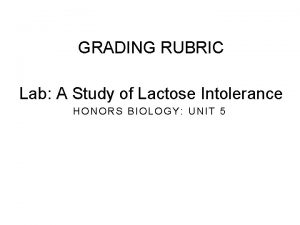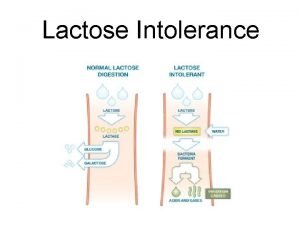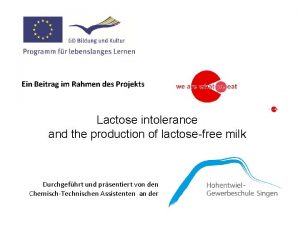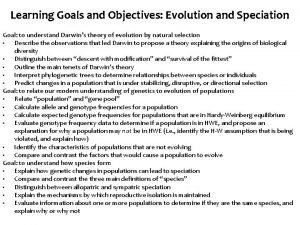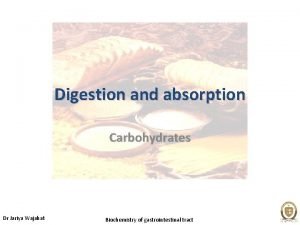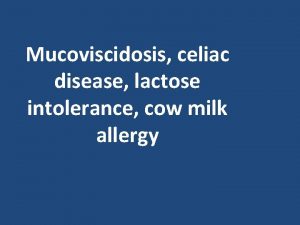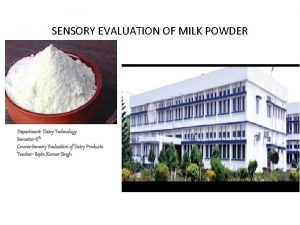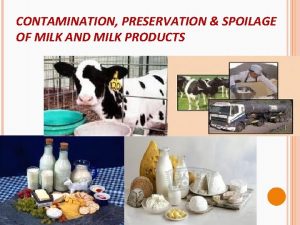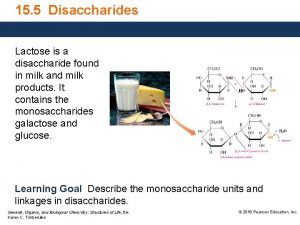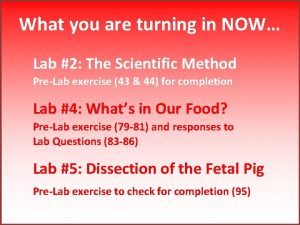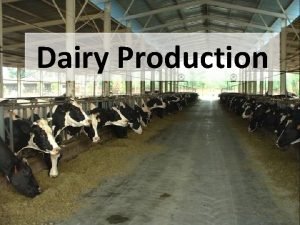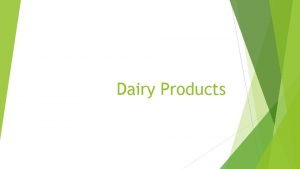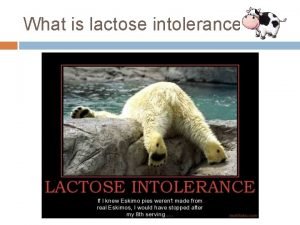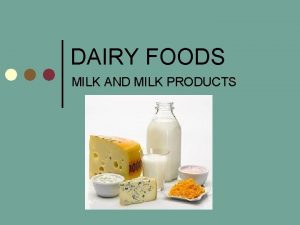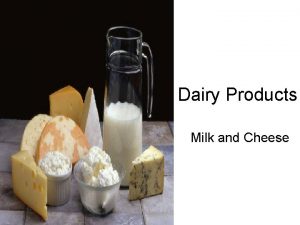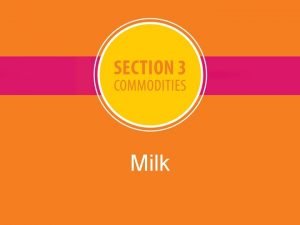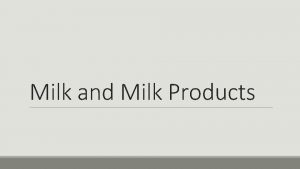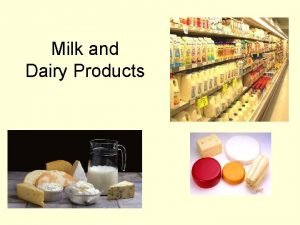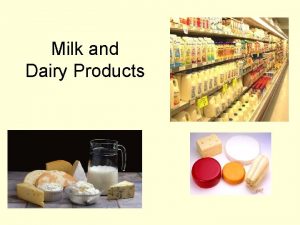Lactose Intolerance Milk and other dairy products contain















- Slides: 15

Lactose Intolerance

Milk and other dairy products contain a sugar or carbohydrate called lactose. Normally, the body breaks down lactose into its simpler components with the help of the enzyme lactase. Most mammals stop producing lactase when they are weaned; humans, however, continue to produce it throughout life. Without enough lactase, a person can have digestive problems like abdominal pain and diarrhoea. This is known as lactose intolerance or lactase deficiency. It is rare for Caucasians to develop lactose intolerance. However, it is quite common among people from Asia, Africa, the Middle East and some Mediterranean countries, as well as among Aboriginal Australians. Up to five per cent of Caucasians and up to 75 per cent of non-Caucasians living in Australia are lactose intolerant.

Symptoms of lactose intolerance Many people with lactose intolerance have a particular tolerance level, which allows them to consume some lactose with minimal symptoms. Symptoms of lactose intolerance include: • • Abdominal pain Abdominal swelling Flatulence Diarrhoea. Symptoms of lactose intolerance are often confused with symptoms of irritable bowel syndrome (IBS). People with IBS are not lactose intolerant, but tend to have difficulty tolerating fat. If you think you may be lactose intolerant, see your doctor.

Undigested milk sugars The enzyme lactase breaks down milk sugar (lactose). Lactase enzymes are found in the mucus of the small intestine. They change the milk sugar into the absorbable compounds – glucose and galactose. If there is not enough lactase, it skips the usual digestive process and is partially broken down by the bacteria in the intestines. This fermentation process causes excessive wind, bloating and associated pain. Any undigested lactose is sent along the intestinal tract. Water is not removed from the faecal matter and diarrhoea is the result.

Causes of lactose intolerance Lactose intolerance is largely genetically determined. Some causes include: • Congenital – this is the main cause, where your genetic make up causes you to have less lactase than usual. • Gastroenteritis – this can strip the intestines of lactase for a few weeks. • Parasitic infection – this can temporarily reduce lactase levels. • Iron deficiency – lack of iron in the diet can interfere with lactose digestion and absorption.

Lactose intolerance in babies Around two thirds of babies, either breast- or bottle-fed, will experience some degree of lactase deficiency in their early months without it causing them harm. Human breast milk contains around seven per cent lactose. The amount of lactose in breast milk is not affected by the mother’s diet. This means the mother can’t influence the amount of lactose in her milk by reducing or eliminating dairy foods. A bout of gastroenteritis can strip the baby’s small intestine of lactase enzymes, and lactose-free formula may need to be used for a number of weeks until their enzyme levels recover. Lactase drops are another option, but these are not always helpful. A few babies are born without any lactase enzymes at all, and lactose-free formulas may be an option in such cases. Lactose intolerance does not cause vomiting in babies. This may be symptomatic of an allergy to cows’ milk.

Diagnosis methods Various methods may be used to diagnose lactose intolerance, including: • Hydrogen breath test – this tests the amount of hydrogen that is breathed out. When lactose is fermented by bacteria in the bowel, instead of being converted by lactase, more hydrogen is produced. • Elimination diet – this involves removing foods that contain lactose to see if the symptoms improve. If the symptoms reappear once the foods are reintroduced, then lactose intolerance is most likely the cause. Another cheap and simple ‘test’ is to compare whether the person can tolerate lactose-free milk rather than ordinary milk.

Managing lactose intolerance Most people with lactose intolerance can handle small amounts of lactose, such as a glass of milk. However, the following tips may help: • • • Try cheese and yoghurt; they are generally better tolerated than milk. Drink full-fat milk because the fats slow the journey of the milk through the intestines and allow the lactase enzymes more time to break down the sugars. Avoid low-fat or non-fat milks – they travel quickly through the gut and tend to cause symptoms in lactose intolerant people. Also, many low-fat milk products may contain skim milk powder, which provides a higher dose of lactose. Don’t give up milk products entirely. They are very nutritious. Drink milk in moderate quantities. Most people with this condition can tolerate 240 ml of milk per day, but you need to work out your own tolerance level. You can buy milk that has had the lactose broken down, which makes it lactose free. Eat fermented milk products like some yoghurts, mature or ripened cheeses (like cheddar, fetta and mozzarella), and butter – they usually don’t cause problems. Eat foods that contain lactose in combination with other foods or spread them out over the day, rather than eating a large amount at once. Use heated milk products like evaporated milk; they seem to be better tolerated because the heating process breaks down some of the lactose to glucose and galactose. Have soy or other non-dairy products; they are lactose free, (and if commercially produced) are a good source of calcium and can be a good substitute for milk products.

Hidden lactose Foods that may contain hidden lactose include: • Biscuits and cakes (if milk or milk solids are added) • Processed breakfast cereals • Cheese sauce • Cream soups • Custard • Milk chocolate • Pancakes and pikelets • Scrambled eggs • Quiche • Muesli bars • Some breads and margarine (containing

Check the labels If you are trying to avoid lactose, look for the following ingredients in lists on food labels: • Milk solids • Non-fat milk solids • Whey • Milk sugar • and of course, lactose itself! Foods that can be eaten when a person needs to avoid lactose include; • Lactose Free Foods • Dairy Free Foods • Naturally Dairy Free Foods … see some examples on the next few slides. Information from: http: //www. betterhealth. vic. gov. au/bhcv 2/bhcarticles. nsf/pages/Lactose_intolerance

Lactose Free Products (lactose removed)

Dairy-free products (lactose was never present, due to lack of milk)

Dairy-free products (lactose was never present, due to lack of milk … although with these milks, commercially prepared ones have calcium added in)

Naturally Lactose free foods

If you want to have a discussion about soy and its health/non -health benefits … http: //www. huffingtonpost. com/dr-mercola/soy-health_b_1822466. html
 Lactose test strips
Lactose test strips Intolérance au lactose
Intolérance au lactose Lactose intolerance by ethnicity
Lactose intolerance by ethnicity Lactose free milk
Lactose free milk Lactose intolerance histology
Lactose intolerance histology Lactose intolerance gene
Lactose intolerance gene Digestion and absorption of carbohydrates biochemistry
Digestion and absorption of carbohydrates biochemistry Milk for toddlers with milk allergynon dairy
Milk for toddlers with milk allergynon dairy Sensory evaluation of milk and milk products
Sensory evaluation of milk and milk products Contamination of milk and milk products
Contamination of milk and milk products Lactose disaccharide
Lactose disaccharide Lactose free milk
Lactose free milk Deepthi thomas
Deepthi thomas Product life cycle of oreo
Product life cycle of oreo Objective of dairy farming
Objective of dairy farming Best milk a typical profit-maximizing dairy firm
Best milk a typical profit-maximizing dairy firm
